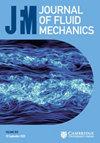Data-driven transient lift attenuation for extreme vortex gust–airfoil interactions
IF 3.9
2区 工程技术
Q1 MECHANICS
引用次数: 0
Abstract
We present a data-driven feedforward control to attenuate large transient lift experienced by an airfoil disturbed by an extreme level of discrete vortex gust. The current analysis uses a nonlinear machine-learning technique to compress the high-dimensional flow dynamics onto a low-dimensional manifold. While the interaction dynamics between the airfoil and extreme vortex gust are parametrized by its size, gust ratio and position, the wake responses are well captured on this simple manifold. The effect of extreme vortex disturbance about the undisturbed baseline flows can be extracted in a physically interpretable manner. Furthermore, we call on phase-amplitude reduction to model and control the complex nonlinear extreme aerodynamic flows. The present phase-amplitude reduction model reveals the sensitivity of the dynamical system in terms of the phase shift and amplitude change induced by external forcing with respect to the baseline periodic orbit. By performing the phase-amplitude analysis for a latent dynamical model identified by sparse regression, the sensitivity functions of low-dimensionalized aerodynamic flows for both phase and amplitude are derived. With the phase and amplitude sensitivity functions, optimal forcing can be determined to quickly suppress the effect of extreme vortex gusts towards the undisturbed states in a low-order space. The present optimal flow modification built upon the machine-learned low-dimensional subspace quickly alleviates the impact of transient vortex gusts for a variety of extreme aerodynamic scenarios, providing a potential foundation for flight of small-scale air vehicles in adverse atmospheric conditions.极端涡旋阵风与翼面相互作用的数据驱动瞬态升力衰减
我们提出了一种数据驱动的前馈控制,用于减弱受极端离散涡流阵风干扰的机翼所经历的巨大瞬态升力。目前的分析采用非线性机器学习技术,将高维流动动力学压缩到低维流形上。虽然机翼与极端涡旋阵风之间的相互作用动力学由其大小、阵风比和位置参数化,但在这个简单的流形上可以很好地捕捉尾流响应。极端涡流扰动对未扰动基线流的影响可以通过物理解释的方式提取出来。此外,我们还利用相位振幅还原来模拟和控制复杂的非线性极端气动流。本相位-振幅还原模型揭示了动力系统的敏感性,即相对于基线周期轨道而言,外部强迫引起的相移和振幅变化。通过对稀疏回归确定的潜在动力学模型进行相位-振幅分析,得出了低维度空气动力流的相位和振幅灵敏度函数。利用相位和振幅灵敏度函数,可以确定最佳强制力,从而在低阶空间内快速抑制极端涡旋阵风对未扰动状态的影响。建立在机器学习低维子空间基础上的优化流场修正可以快速缓解各种极端气动情况下瞬态涡旋阵风的影响,为小型飞行器在恶劣大气条件下的飞行提供了潜在的基础。
本文章由计算机程序翻译,如有差异,请以英文原文为准。
求助全文
约1分钟内获得全文
求助全文
来源期刊
CiteScore
6.50
自引率
27.00%
发文量
945
审稿时长
5.1 months
期刊介绍:
Journal of Fluid Mechanics is the leading international journal in the field and is essential reading for all those concerned with developments in fluid mechanics. It publishes authoritative articles covering theoretical, computational and experimental investigations of all aspects of the mechanics of fluids. Each issue contains papers on both the fundamental aspects of fluid mechanics, and their applications to other fields such as aeronautics, astrophysics, biology, chemical and mechanical engineering, hydraulics, meteorology, oceanography, geology, acoustics and combustion.

 求助内容:
求助内容: 应助结果提醒方式:
应助结果提醒方式:


